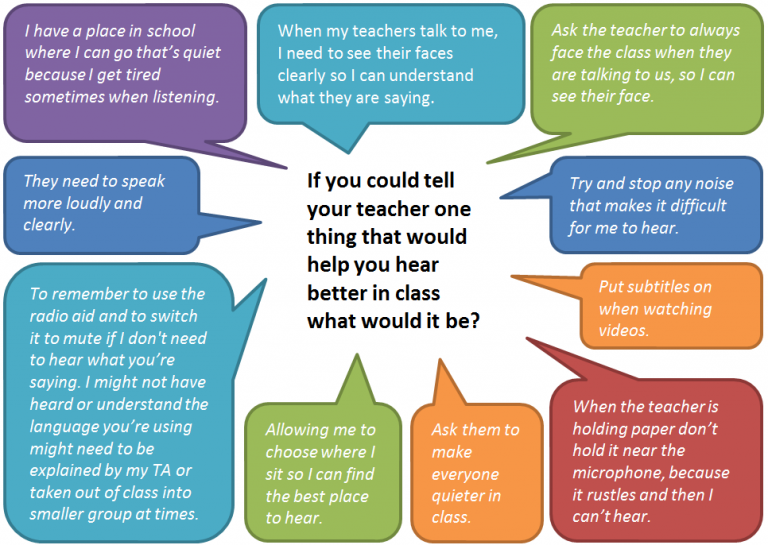 Supporting a primary school age child’s language development in school can pose challenges but also is wonderfully rewarding. Often children implanted as babies have become experienced and proficient listeners before they reach school. They may have developed aged appropriate language on formal tests. However, even if a child’s vocabulary and language seem to be developing well, a child with implants can still experience difficulties for example socially integrating at lunch times in noisy dining halls or play grounds and understanding more complex language in the classroom especially when there is background noise etc.
Supporting a primary school age child’s language development in school can pose challenges but also is wonderfully rewarding. Often children implanted as babies have become experienced and proficient listeners before they reach school. They may have developed aged appropriate language on formal tests. However, even if a child’s vocabulary and language seem to be developing well, a child with implants can still experience difficulties for example socially integrating at lunch times in noisy dining halls or play grounds and understanding more complex language in the classroom especially when there is background noise etc.
How do the communication demands of life in school increase as children move up through primary school? Click on the titles below to find out more.
Language becomes:
There are many factors that will affect the child’s progress with his or her language development and how will s/he will cope with the demands mentioned above and how support in school is managed. These issues need to be considered on a case by case basis.
Tips for teachers
We asked children and teenagers what advice they would give their teacher to enable them to hear better in class.

 Have high expectations for children with cochlear implants. With fully working equipment, children can hear your speech at normal levels of loudness. With good spoken language input, they can learn to pay attention to it, begin to decode it and eventually understand it.
Have high expectations for children with cochlear implants. With fully working equipment, children can hear your speech at normal levels of loudness. With good spoken language input, they can learn to pay attention to it, begin to decode it and eventually understand it.- Consider the multi-sensory learning needs of the child at any given time. Does the child need clues from other senses e.g. extra visual clues, in order to understand? Alternatively does s/he need more practice at listening without the visual clues? If a child has understanding of sign and uses sign but does not yet have understanding of spoken words or listening experience e.g. if newly implanted, then you will be working at a higher level for his/her language development of sign and a lower level for listening and spoken language development.
- Talk children through their tasks as they do them, as well as re-capping afterwards. Pre-tutoring topics before lessons can also be helpful too.
- Teach the child the sequence of time. As this is abstract, visual clues are extremely beneficial for example a visual timetable of the school day or week – click on the link for examples. https://www.tes.com/teaching-resources/blog/visual-timetables-all-ages When children know what is going to happen, it enables anticipation of events and takes away his/her fear. Children who feel secure emotionally, learn language better. It is also an opportunity for the child to hear the same spoken language but with different tenses, for example at the beginning of the day: “….this afternoon we will have circle time…” And at the end of the day: “Today we had circle time…”
- Appreciate that the child with cochlear implants will miss vital social chit chat of their peers. Children with implants can not overhear others’ conversations easily because of the limitations of their microphones.
- Involving parents. Children usually have more 1:1 interactions with their parents than with anyone else and parents tend to be naturally in tune with the vocabulary their child can understand. Also, they have a vested interest in helping their child and therefore tend to be highly motivated.
- Consider setting some specific objectives for the child’s understanding and spoken language development (e.g. IEP/EHCP or informal objectives) not just for the child’s hearing and listening need. Local professionals can help advise on these.
- Give the child more time to process what s/he hears. This can take many seconds. Don’t be too quick to jump in and help or to repeat what you said.
- Be aware of the possible knock on effects of hearing loss and language delay for phonics, reading and extended writing skills. The NDCS has some good resources.
- Give more time at the early stages of phonics e.g. discriminating, identifying and sequencing both non speech and speech sounds can be useful. Don’t move on too quickly if skills at that level have not been consolidated.
- Allow the child to thrive and advance in those areas where they demonstrate ability. Remember a child with a CI may struggle with literacy or vocabulary skills but be an able, keen learner in other areas.
- Teach the skills needed to become a good listener directly to the class. The whole class will benefit from considering what makes a good listener. An example of an activity is asking the group to listen to a story etc with a loud radio on a talking channel and then with music and with no background noise and discussing what they found out about their own listening ability
Key concepts
- What are the communication options for a child with a cochlear implant?
- What factors are important to consider in the early stages after implantation?
- How to support a child with a cochlear implant with language development in primary school.
- Understanding the importance of social interaction.
- What resources are available to support primary school staff.
